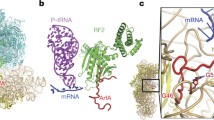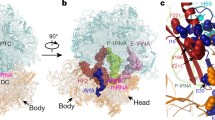Abstract
The bacterial release factor RF3 is a GTPase that has been implicated in multiple, incompletely understood steps of protein synthesis. This study explores the genetic interaction of RF3 with other components of the translation machinery. RF3 contributes to translation termination by recycling the class I release factors RF1 and RF2 off post-termination ribosomes. RF3 has also been implicated in dissociation of peptidyl-tRNAs from elongating ribosomes and in a post-peptidyltransferase quality control (post-PT QC) mechanism that selectively terminates ribosomes carrying erroneous peptides. A majority of the in vivo studies on RF3 have been carried out in K-12 strains of Escherichia coli which carry a partially defective RF2 protein with an Ala to Thr substitution at position 246. Here, the contribution of the K-12 specific RF2 variant to RF3 activities has been investigated. Strain reconstruction experiments in both E. coli and Salmonella enterica demonstrate that defects in termination and post-PT QC that are associated with RF3 loss, as well as phenotypes uncovered by phenotypic profiling, are all substantially ameliorated when the incompletely active K-12-specific RF2 protein is replaced by a fully active Ala246 RF2. These results indicate that RF3 loss is well tolerated in bacteria with fully active class I release factors, but that many of the previously reported phenotypes for RF3 deletion strains have been compromised by the presence of a partially defective RF2.





Similar content being viewed by others
References
Agarwal D, Gregory ST, O’Connor M (2011) Error-prone and error-restrictive mutations affecting ribosomal protein S12. J Mol Biol 410:1–9
Andersson DI, Andersson SG, Kurland CG (1986) Functional interactions between mutated forms of ribosomal proteins S4, S5 and S12. Biochimie 68:705–713
Baba T, Ara T, Hasegawa M, Takai Y, Okumura Y, Baba M, Datsenko KA, Tomita M, Wanner BL, Mori H (2006) Construction of Escherichia coli K-12 in-frame, single-gene knockout mutants: the Keio collection. Mol Syst Biol 2(2006):0008
Bjare U, Gorini L (1971) Drug dependence reversed by a ribosomal ambiguity mutation, ram, in Escherichia coli. J Mol Biol 57:423–435
Bjorkman J, Samuelsson P, Andersson DI, Hughes D (1999) Novel ribosomal mutations affecting translational accuracy, antibiotic resistance and virulence of Salmonella typhimurium. Mol Microbiol 31:53–58
Capecchi MR, Klein HA (1969) Characterization of three proteins involved in polypeptide chain termination. Cold Spring Harb Symp Quant Biol 34:469–477
Caskey T, Scolnick E, Tompkins R, Goldstein J, Milman G (1969) Peptide chain termination, codon, protein factor, and ribosomal requirements. Cold Spring Harb Symp Quant Biol 34:479–488
Dahlgren A, Ryden-Aulin M (2000) A novel mutation in ribosomal protein S4 that affects the function of a mutated RF1. Biochimie 82:683–691
Datsenko KA, Wanner BL (2000) One-step inactivation of chromosomal genes in Escherichia coli K-12 using PCR products. Proc Natl Acad Sci USA 97:6640–6645
Dincbas V, Heurgue-Hamard V, Buckingham RH, Karimi R, Ehrenberg M (1999) Shutdown in protein synthesis due to the expression of mini-genes in bacteria. J Mol Biol 291:745–759
Dincbas-Renqvist V, Engstrom A, Mora L, Heurgue-Hamard V, Buckingham R, Ehrenberg M (2000) A post-translational modification in the GGQ motif of RF2 from Escherichia coli stimulates termination of translation. EMBO J 19:6900–6907
Freistroffer DV, Pavlov MY, MacDougall J, Buckingham RH, Ehrenberg M (1997) Release factor RF3 in E.coli accelerates the dissociation of release factors RF1 and RF2 from the ribosome in a GTP-dependent manner. EMBO J 16:4126–4133
Gong M, Cruz-Vera LR, Yanofsky C (2007) Ribosome recycling factor and release factor 3 action promotes TnaC-peptidyl-tRNA Dropoff and relieves ribosome stalling during tryptophan induction of tna operon expression in Escherichia coli. J Bacteriol 189:3147–3155
Grentzmann G, Brechemier-Baey D, Heurgue V, Mora L, Buckingham RH (1994) Localization and characterization of the gene encoding release factor RF3 in Escherichia coli. Proc Natl Acad Sci USA 91:5848–5852
Grentzmann G, Brechemier-Baey D, Heurgue-Hamard V, Buckingham RH (1995) Function of polypeptide chain release factor RF-3 in Escherichia coli. RF-3 action in termination is predominantly at UGA-containing stop signals. J Biol Chem 270:10595–10600
Kipper K, Sild S, Hetenyi C, Remme J, Liiv A (2011) Pseudouridylation of 23S rRNA helix 69 promotes peptide release by release factor RF2 but not by release factor RF1. Biochimie 93:834–844
Kisselev LL, Buckingham RH (2000) Translational termination comes of age. Trends Biochem Sci 25:561–566
Margus T, Remm M, Tenson T (2007) Phylogenetic distribution of translational GTPases in bacteria. BMC Genom 8:15
Mikuni O, Ito K, Moffat J, Matsumura K, McCaughan K, Nobukuni T, Tate W, Nakamura Y (1994) Identification of the prfC gene, which encodes peptide-chain-release factor 3 of Escherichia coli. Proc Natl Acad Sci USA 91:5798–5802
Miller J (1972) Experiments in molecular genetics. Cold Spring Harbor Laboratory Press, New York
Miller JH (1991) A short course in bacterial genetics. Cold Spring Harbor Laboratory Press, New York
Mora L, Heurgue-Hamard V, de Zamaroczy M, Kervestin S, Buckingham RH (2007) Methylation of bacterial release factors RF1 and RF2 is required for normal translation termination in vivo. J Biol Chem 282:35638–35645
Nichols RJ, Sen S, Choo YJ, Beltrao P, Zietek M, Chaba R, Lee S, Kazmierczak KM, Lee KJ, Wong A, Shales M, Lovett S, Winkler ME, Krogan NJ, Typas A, Gross CA (2011) Phenotypic landscape of a bacterial cell. Cell 144:143–156
O’Connor M, Gregory ST (2011) Inactivation of the RluD pseudouridine synthase has minimal effects on growth and ribosome function in wild-type Escherichia coli and Salmonella enterica. J Bacteriol 193:154–162
O’Connor M, Thomas CL, Zimmermann RA, Dahlberg AE (1997) Decoding fidelity at the ribosomal A and P sites: influence of mutations in three different regions of the decoding domain in 16S rRNA. Nucleic Acids Res 25:1185–1193
Petropoulos AD, McDonald ME, Green R, Zaher HS (2014) Distinct roles for release factor 1 and release factor 2 in translational quality control. J Biol Chem 289:17589–17596
Schaub RE, Hayes CS (2011) Deletion of the RluD pseudouridine synthase promotes SsrA peptide tagging of ribosomal protein S7. Mol Microbiol 79:331–341
Vogel HJ, Bonner DM (1956) Acetylornithinase of Escherichia coli: partial purification and some properties. J Biol Chem 218:97–106
Zaher HS, Green R (2009) Quality control by the ribosome following peptide bond formation. Nature 457:161–166
Zaher HS, Green R (2011) A primary role for release factor 3 in quality control during translation elongation in Escherichia coli. Cell 147:396–408
Acknowledgments
I am indebted to Dr Diarmaid Hughes, University of Uppsala, for supplying S. enterica strains and to Drs. Steven Gregory and Jennifer Carr for their comments on the manuscript.
Author information
Authors and Affiliations
Corresponding author
Additional information
Communicated by D. Andersson.
Electronic supplementary material
Below is the link to the electronic supplementary material.
Rights and permissions
About this article
Cite this article
O’Connor, M. Interactions of release factor RF3 with the translation machinery. Mol Genet Genomics 290, 1335–1344 (2015). https://doi.org/10.1007/s00438-015-0994-x
Received:
Accepted:
Published:
Issue Date:
DOI: https://doi.org/10.1007/s00438-015-0994-x




